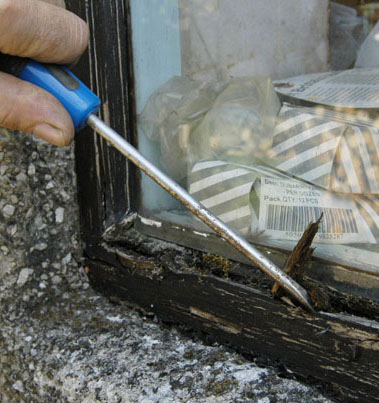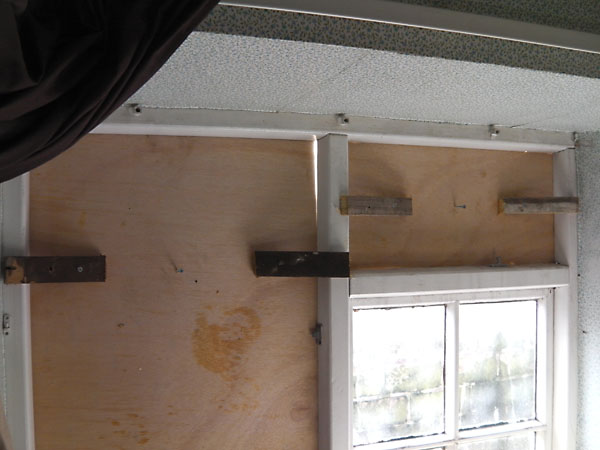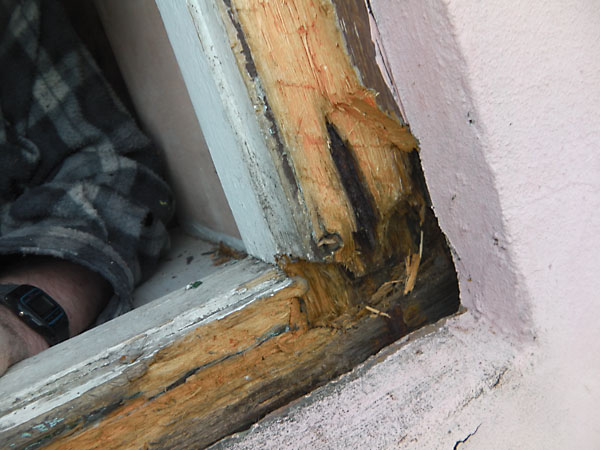How to Investigate Rotten Window Frames
If you've arrived here direct from a search, you might want to read the full set of pages starting here
Screwdriver test for rotten windows
 Windows that have been identified as needing repair i.e. You can see or feel the timber has started to rot, will need a full investigation to check the extent of the problems. A good poke around with a screwdriver will give a reasonable indication of the extent of any problems that could be hidden under multiple layers of paint. If the screwdriver sinks in then you’ll have a much better idea of what will have to be repaired. Bear in mind that rot can often extend under a surface layer of good wood.
Windows that have been identified as needing repair i.e. You can see or feel the timber has started to rot, will need a full investigation to check the extent of the problems. A good poke around with a screwdriver will give a reasonable indication of the extent of any problems that could be hidden under multiple layers of paint. If the screwdriver sinks in then you’ll have a much better idea of what will have to be repaired. Bear in mind that rot can often extend under a surface layer of good wood.
Now it’s a decision time. Is it worth repairing? Or is it really past it?
Only you, through either experience or just from a willingness to put the time and effort in, will be able to decide. You can factor in the desire to maintain the original frame and weigh this up with the cost to purchase (or make) and install a new frame.
Any window, in any state can be repaired but sometimes there is so much that needs doing a replacement is really the better option.
Deeper window investigations
So you’ve decided to give it a go, now is the time to get serious with a chisel and mallet. Don’t use your best chisel, you are likely to hit a nail / frame fixing or two. I have a number second class chisels for jobs like these.
If it looks like any of the opening lights or sliding sashes will need serious work it’ll be easier to remove them so you can work on them on a bench. As these are going to be in your workshop for a few days, simple removable shutters can be made up to keep the draughts out and rooms dry.


Simple temporary shutters. 4mm ply (thicker if security is an issue).Two horizontal batons on the outside approximately ¼ up and ¼ down. Held in place with simple timber latches, held on with long screws, these can be tightened up, clamping on to the inside of the frame without causing any damage.
Start digging away at the rotten timber
Any really rotten material will be easy to gouge out but there will be much more to remove. In my experience at around an inch (25mm), surrounding the really soft material will need to be taken out to get to sound, undamaged timber (You don’t have to remove it all just yet but you do need to know where the good wood starts). As mentioned before, rot is likely to have extended under the surface, following along the grain from the original source. It’s not worth trying to save any of these undermined surfaces.
Caution: be careful chiselling close to glass, one tap in the wrong place could cost you time and expense you wanted to avoid.
You might find you are taking out so much that there’s going to be nothing left of corners or the glass is going to be unsupported. Whole rails or stiles might need replacing so you might want to reassess your “repair or replace” the window decision. Alternatively start thinking about whether you can build, cut, fashion new sections . In any of these cases it may be necessary to stabilise the structure by screwing temporary timber to it.
What to cut Away and What to Leave
Most of the advice you will get on this is to remove every piece of timber that is discoloured and then some more. The only reason I can see for this is vain attempt to remove traces of fungus spores. I take a different view based on the conditions that rot and insects need before they can damage timber.
 They need moisture, at levels consistently over 20% to take a hold and to start causing any real damage. If the repairs are successful the moisture will remain below this level.
They need moisture, at levels consistently over 20% to take a hold and to start causing any real damage. If the repairs are successful the moisture will remain below this level.
With this in mind it is acceptable to leave some timber even if it is discoloured from fungus attack. You just have to decide if it will still perform it structural function. But do make sure all loose and soft timber is removed.
The next steps will involve cutting back further in to the good wood providing solid fixing points for new pieces of timber and or filler. Along the grain this will be around 25mm (inch) past the really soft material and less across the grain. But you should leave this until you have the replacement pieces ready.
Previous - Window repairs intro and index
Please post any questions, comments or suggestions over on the blog
Window repairs intro and index
Investigating the extent of damage
Making good a timber frame or sash
Other Window problems and considerations including sash window double glazing
Filling and sanding window repairs

